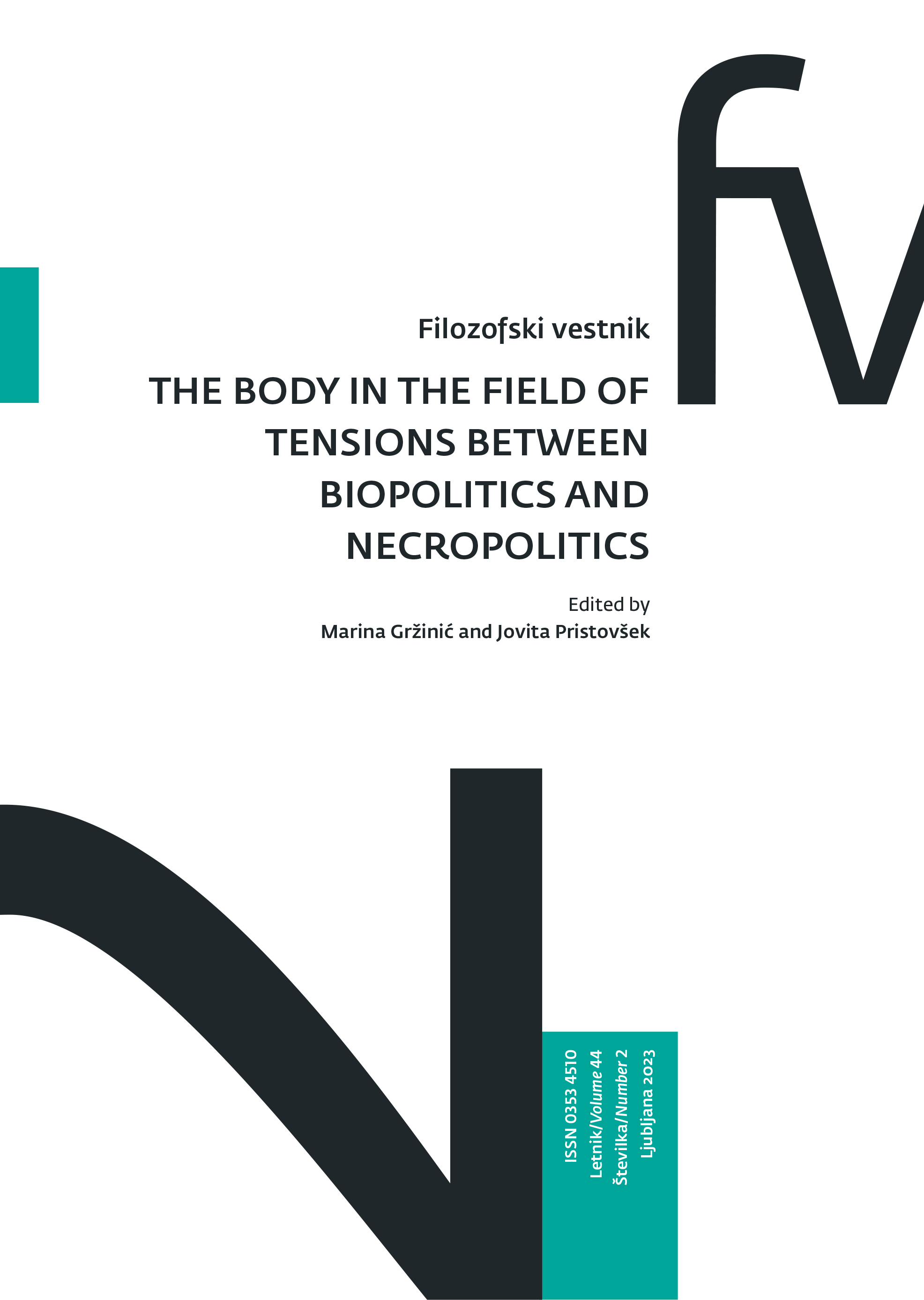Telo v umu
vloga telesa v Damasijevi teoriji čustev
DOI:
https://doi.org/10.3986/fv.44.2.10Ključne besede:
Antonio Damasio, čustva, telo, um, utelešena kognicijaPovzetek
V zadnjih nekaj desetletjih je čustvo postalo ena izmed osrednjih tem v številnih znanstvenih disciplinah. Nevroznanstvene raziskave so razvile veliko orodij in pristopov za preučevanje čustev pri ljudeh in živalih. V tem smislu je delo Antonia Damasia pomembno pri odkrivanju fizioloških mehanizmov čustev in občutkov ter njihove vloge pri homeostatski regulaciji. V nekaterih vidikih je njegova teorija izzvala našo vsakodnevno intuicijo o tem, kaj so čustva. Namen tega članka je pokazati, da Damasijev opis afektov poudarja pomen telesa pri generiranju občutkov in subjektivnih zavestnih izkušenj ter da lahko ta pogled na dvosmerno komunikacijo med telesom in možgani ponudi svež vpogled v dualizem uma in telesa.
Prenosi
Literatura
Adolphs, Ralph, and David J. Anderson. The Neuroscience of Emotion: A New Synthesis. Princeton: Princeton University Press, 2018.
Billman, George E. “Homeostasis: The Underappreciated and Far Too Often Ignored Central Organizing Principle of Physiology.” Frontiers of Physiology 11 (March 2020): article 200. https://doi.org/10.3389/fphys.2020.00200.
Cannon, Walter B. The Wisdom of the Body. New York: W. W. Norton, 1932.
Chalmers, David. “Facing up to the Problem of Consciousness.” Journal of Consciousness Studies 2, no. 3 (1995): 200–19.
Craig, A. D. (Bud). How do You Feel? An Interoceptive Moment with Your Neurobiological Self. Princeton: Princeton University Press, 2015.
Craig, A. D. (Bud). “Interoception: The Sense of the Physiological Condition of the Body.” Current Opinion in Neurobiology 13, no. 4 (August 2003): 500–5. https://doi.org/10.1016/S0959-4388(03)00090-4.
Damasio, Antonio. Descartes’ Error: Emotion, Reason and the Human Brain. London: Vintage Books, 2006.
Damasio, Antonio. Feeling and Knowing: Making Minds Conscious. London: Robinson, 2021.
Damasio, Antonio. “Feeling Our Emotions.” Interview by Manuela Lenzen. Scientific American Mind 16, no. 1 (April 2005): 14–15. https://doi.org/10.1038/scientificamericanmind0405-14.
Damasio, Antonio. Looking for Spinoza: Joy, Sorrow and the Feeling Brain. Orlando: Harvest, 2003.
Damasio, Antonio. Self Comes to Mind: Constructing the Conscious Brain. London: Vintage Books, 2012.
Damasio, Antonio. “Toward a Neurobiology of Emotion and Feeling: Operational Concepts and Hypotheses.” Neuroscientist 1, no. 1 (January 1995): 19–25. https://doi.org/10.1177/107385849500100104.
Damasio, Antonio, and Anil Seth. “What’s so Hard About Understanding Consciousness?” Interview by Kristen French. Nautilus, February 2, 2022. https://nautil.us/whats-so-hard-about-understanding-consciousness-238421/.
Damasio, Antonio, Daniel Tranel, and Hanna Damasio. “Somatic Markers and the Guidance of Behavior: Theory and Preliminary Testing.” In Frontal Lobe Function and Dysfunction, edited by Harvey S. Levin, Howard M. Eisenberg, and Arthur L. Benton, 217–29. New York: Oxford University Press, 1991.
Damasio, Antonio, Thomas J. Grabowski, Antoine Bechara, Hanna Damasio, Laura L.B. Ponto, Josef Parvizi, and Richard D. Hichwa. “Subcortical and Cortical Brain Activity During the Feeling of Self-Generated Emotions.” Nature Neuroscience 3 (October 2000): 1049–56. https://doi.org/10.1038/79871.
James, William. “What is an Emotion?” Mind 9, no. 34 (April 1884): 188–205. https://doi.org/10.1093/mind/os-IX.34.188.
Jasanoff, Alan. The Biological Mind: How Brain, Body, and Environment Collaborate to Make Us Who We Are. New York: Basic Books, 2018.
Kandel, Eric R. In Search of Memory: The Emergence of a New Science of Mind. New York: W. W. Norton, 2006.
Koch, Christof, Marcello Massimini, Melanie Boly, and Giulio Tononi. “Neural Correlates of Consciousness: Progress and Problems.” Nature Reviews Neuroscience 17 (May 2016): 307–21. https://doi.org/10.1038/nrn.2016.22.
Kupfermann, Irving, Vincent Castellucci, Harold Pinsker, and Eric Kandel. “Neuronal Correlates of Habituation and Dishabituation of the Gill-Withdrawal Reflex in Aplysia.” Science 167, no. 3926 (March 1970): 1743–45. https://doi.org/10.1126/science.167.3926.1743.
LeDoux, Joseph E. “The Emotional Brain, Fear, and the Amygdala.” Cellular and Molecular Neurobiology 23, no. 4–5 (October 2003): 727–38. https://doi.org/10.1023/A:1025048802629.
LeDoux, Joseph E. “Rethinking the Emotional Brain.” Neuron 73, no. 4 (February 2012): 653–76. https://doi.org/10.1016/j.neuron.2012.02.004.
LeDoux, Joseph E. “What Emotions Might Be Like in Other Animals.” Current Biology 31 (July 2021): R821–37. https://doi.org/10.1016/j.cub.2021.05.005.
Mahon, Bradford Z., Michelle Miozzo, and Webster H. Pilcher. “Direct Electrical Stimulation Mapping of Cognitive Functions in the Human Brain.” Cognitive Neuropsychology 36, no. 3–4 (2019): 97–102. https://doi.org/10.1080/02643294.2019.1630375.
McCulloch, Warren S., and Walter Pitts. “A Logical Calculus of the Ideas Immanent in Nervous Activity.” The Bulletin of Mathematical Biophysics 5 (December 1943): 115–33. https://doi.org/10.1007/BF02478259.
Merleau-Ponty, Maurice. Phenomenology of Perception. Translated by Colin Smith. London: Routledge, 1962.
Panksepp, Jaak. Affective Neuroscience: The Foundations of Human and Animal Emotions. Oxford: Oxford University Press, 1998.
Prinz, Jesse J. Gut Reactions: A Perceptual Theory of Emotion. Oxford: Oxford University Press, 2004.
Scarantino, Andrea, and Ronald de Sousa. “Emotions.” Stanford Encyclopedia of Philosophy. September 25, 2018. https://plato.stanford.edu/entries/emotion/.
Schweisfurth, Meike A., Jens Frahm, and Renate Schweizer. “Individual fMRI Maps of All Phalanges and Digit Bases of All Fingers in Human Primary Somatosensory Cortex.” Frontiers in Human Neuroscience 8 (September 2014): article 658. https://doi.org/10.3389/fnhum.2014.00658.
Shapiro, Lawrence, and Shannon Spaulding. “Embodied Cognition.” Stanford Encyclopedia of Philosophy. June 25, 2021. https://plato.stanford.edu/entries/embodied-cognition/.
Yilmaz, Melis, and Markus Meister. “Rapid Innate Defensive Responses of Mice to Looming Visual Stimuli.” Current Biology 23, no. 20 (October 2013): 2011–15. https://doi.org/10.1016/j.cub.2013.08.015.
Young, Liane, Antoine Bechara, Daniel Tranel, Hanna Damasio, Marc Hauser, and Antonio Damasio. “Damage to Ventromedial Prefrontal Cortex Impairs Judgment of Harmful Intent.” Neuron 65, no. 6 (March 2010): 845–51. https://doi.org/10.1016/j.neuron.2010.03.003.
Prenosi
Objavljeno
Kako citirati
Številka
Rubrike
Licenca
Avtorske pravice (c) 2023 Avtorji

To delo je licencirano pod Creative Commons Priznanje avtorstva-Deljenje pod enakimi pogoji 4.0 mednarodno licenco.
Avtorji jamčijo, da je delo njihova avtorska stvaritev, da v njem niso kršene avtorske pravice tretjih oseb ali kake druge pravice. V primeru zahtevkov tretjih oseb se avtorji zavezujejo, da bodo varovali interese založnika ter da bodo povrnili morebitno škodo.
Podrobneje v rubriki: Prispevki





